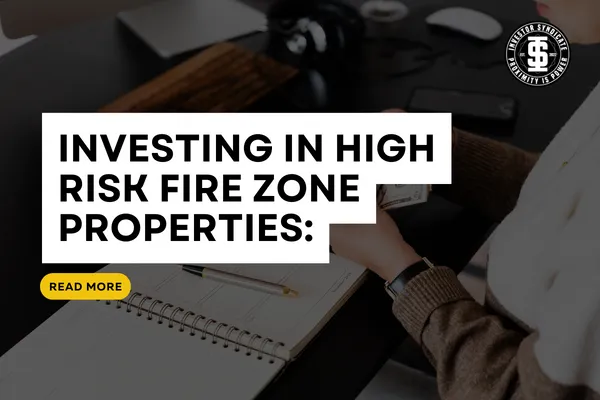Investor Syndicate Blogs
Download The Deal Flipping Playbook

Investing in High Risk Fire Zone Properties: Essential Tips
Introduction
Investing in properties located in high-risk fire zones can be a daunting prospect, yet it can also offer unique opportunities. For those willing to take on the challenge, understanding the risks and preparing strategies to mitigate them is crucial.

Understanding the Risks
It’s essential to grasp the implications of owning property in a fire-prone area. High-risk fire zones are designated due to factors such as local climate, vegetation, and historical fire activity. Properties in these areas are more susceptible to wildfires, which can pose threats to physical safety, property integrity, and financial stability. Therefore, a thorough risk assessment is the first step in your investment journey.
Insurance Considerations
Insurance is a critical element when investing in fire zone areas. Engage with insurance providers to understand coverage options and limitations. It’s worth noting that insurance premiums in high-risk zones may be substantially higher, reflecting the increased risk. Ensure that the policy covers not only the property itself but also potential loss of rental income during recovery from fire damage.
Building and Landscaping for Fire Resistance
Investing in or upgrading to fire-resistant materials for structures is a proactive step. Materials that comply with the latest fire safety standards can significantly reduce the risk of property damage. Additionally, strategic landscaping can serve as a natural barrier against fires. Opt for fire-retardant plants and maintain a defensible space around the property to minimize fire spread.
Community Fire Prevention Programs
Active participation in community fire prevention programs is advantageous. These programs often provide resources and support for property owners in high-risk areas. They also foster a collective approach to fire safety, which can be more effective than individual efforts.
Legal and Compliance Issues
Stay informed about local regulations and building codes specific to fire-prone areas. Compliance with these regulations not only reduces the risk of fire damage but also ensures that the property remains insurable and its value is protected.
Location and Accessibility
When selecting a property, consider its location and accessibility for emergency services. Properties that are easily accessible by fire departments are less risky than those in remote areas. Moreover, proximity to fire stations can sometimes lead to lower insurance premiums.
Emergency Preparedness and Evacuation Plans
Developing a comprehensive emergency preparedness plan is essential. This includes creating evacuation routes, having a communication strategy in place, and understanding the local emergency response protocols. Tenants should be informed of these plans to ensure their safety.

Financial Buffer for Unforeseen Expenses
Given the increased risk, it’s wise to have a financial buffer for unforeseen expenses related to fire incidents. This could include funds for property rehabilitation, landscaping restoration, and coverage for insurance deductibles. Here are three examples of how one might establish such a buffer:
Emergency Savings Fund: This is a dedicated savings account where you set aside a certain amount of money, typically enough to cover three to six months' worth of living expenses or operational costs. This fund is used exclusively for unexpected expenses, such as emergency repairs, sudden income loss, or other unplanned financial needs.
Line of Credit: Establishing a line of credit with a financial institution provides access to funds that can be drawn upon when needed. This is particularly useful for handling immediate expenses without the need to liquidate assets. The key is to have this line of credit set up in advance, ensuring it’s available when an unforeseen expense arises.
Liquid Investment Assets: Investments in liquid assets such as money market funds, short-term bonds, or high-yield savings accounts can serve as a financial buffer. These assets can be quickly converted into cash without significant loss of value, providing a safety net in case of financial emergencies.
Investor Due Diligence
Conducting due diligence before purchasing a property in a high-risk fire zone cannot be overstated. This includes researching the history of wildfires in the area, understanding seasonal fire patterns, and assessing future fire risk projections.
Financial Analysis: This involves a thorough review of the financial statements and records of the investment opportunity. For real estate, this could mean examining cash flow statements, maintenance costs, property taxes, and rental income history. In the case of a business investment, it would include scrutinizing balance sheets, profit and loss statements, and revenue projections. The goal is to assess the financial health and potential profitability of the investment.
Market Research: Conducting detailed market research is crucial. This means analyzing the local real estate market trends, including property values, rental rates, occupancy rates, and demand for housing or commercial space in the area. For a business investment, it involves understanding the industry dynamics, market size, growth potential, and competitive landscape. Market research helps in evaluating the viability and future growth potential of the investment.
Legal Compliance and Verification: This step involves ensuring that all legal aspects of the investment are in order. For real estate, this includes verifying property titles, zoning laws, and compliance with local regulations. For a business investment, it involves checking for any legal disputes, patent or intellectual property issues, and ensuring compliance with regulatory requirements. This due diligence is essential to avoid any legal complications post-investment.
Diversification of Investment Portfolio
To mitigate risk, consider diversifying your investment portfolio. Instead of concentrating all your resources in high-risk fire zone properties, spread your investments across different types of properties and locations.
Asset Class Diversification: This involves spreading your investments across different asset classes such as stocks, bonds, real estate, and cash. Each asset class responds differently to market conditions, so when one class underperforms, another might outperform, helping to balance your portfolio. For instance, while stocks offer growth potential, bonds can provide steady income and lower volatility.
Geographical Diversification: This strategy involves investing in markets across different countries or regions. Different economies and markets perform independently due to varying factors like political climate, economic growth, and currency values. For example, investing in a mix of U.S., European, Asian, and emerging market stocks can protect your portfolio from being overly affected by economic downturns in one region.
Sector and Industry Diversification: This means investing in a variety of sectors (like technology, healthcare, finance, energy, consumer goods) and industries. Since sectors and industries don't move in tandem, diversifying across them can reduce risk. For example, while the tech sector may be rapidly growing, the energy sector might be experiencing a downturn, and diversification can balance these effects.
Community Resources and Support
Utilize community resources, such as local fire departments and forestry services, for advice on property protection. These resources can provide valuable insights into best practices for safeguarding your investment.
Local Fire Departments: Fire departments often offer educational programs, property assessments, and guidance on fire prevention and safety measures. They can provide specific advice tailored to the unique risks of the local area, including how to create defensible spaces around properties and the best practices for fire-resistant construction.
Forestry Services or Fire Agencies: State and national forestry services or specialized fire agencies often have resources for managing fire-prone landscapes. They can offer insights into managing vegetation, conducting controlled burns to reduce fire risk, and strategies for land and resource management to minimize wildfire hazards.
Community Emergency Response Teams (CERT): CERT programs train volunteers in basic disaster response skills, such as fire safety, light search and rescue, and disaster medical operations. Joining or coordinating with a local CERT can enhance a community's preparedness and response capabilities in case of wildfires.
Long-term Perspective
Investing in high-risk fire zone properties requires a long-term perspective. It’s about balancing the potential for higher returns with the reality of periodic wildfires and their associated costs. Here are five examples illustrating this approach:
Investing in the Stock Market: A long-term perspective in stock market investing means focusing on the potential growth over years or even decades, rather than reacting to short-term market fluctuations. Investors with this viewpoint often choose stocks or funds with a history of steady growth and hold onto these investments through market ups and downs, believing in their long-term potential.
Career Development: In career planning, a long-term perspective might involve pursuing additional education or accepting a lower-paying job that offers valuable experience or training. The idea is that these choices, while perhaps not immediately lucrative, will significantly enhance one's career prospects and earning potential in the future.
Environmental Sustainability: When considering environmental sustainability, a long-term perspective involves making choices that protect and preserve the environment for future generations. This might include investing in renewable energy sources, supporting policies that reduce carbon emissions, or engaging in personal behaviors that minimize one's ecological footprint, all with the future health of the planet in mind.
Conclusion
Investing in high-risk fire zone properties involves a complex interplay of risk management, insurance strategy, community engagement, and property selection. By adhering to the tips outlined above, investors can navigate these challenges and make strategic decisions that enhance the safety and profitability of their investments. Always remember, the goal is not to avoid risk entirely but to manage it effectively.
In summary, high-risk fire zone property investment is not for the faint-hearted. It demands diligence, strategic planning, and a proactive approach to risk management. Nonetheless, with the right knowledge and strategies, such investments can be a rewarding addition to a diversified real estate portfolio.
Contact Us

Bet On Yourself
Empowering real estate investors with the tools they need to scale.






